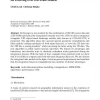Free Online Productivity Tools
i2Speak
i2Symbol
i2OCR
iTex2Img
iWeb2Print
iWeb2Shot
i2Type
iPdf2Split
iPdf2Merge
i2Bopomofo
i2Arabic
i2Style
i2Image
i2PDF
iLatex2Rtf
Sci2ools
GEOINFORMATICA
2006
2006
The Radial Topology Algorithm - A New Approach for Deriving 2.5D GIS Data Models
In this paper a new method for the combination of 2D GIS vector data and 2.5D DTM represented by triangulated irregular networks (TIN) to derive integrated triangular 2.5D object-based landscape models (also known as 2.5D-GIS-TIN) is presented. The algorithm takes into account special geometric constellations and fully exploits existing topologies of both input data sets, it "sews the 2D data into the TIN like a sewing-machine" while traversing the latter along the 2D data. The new algorithm is called radial topology algorithm. We discuss its advantages and limitations, and describe ways to eliminate redundant nodes generated during the integration process. With the help of four examples from practical work we show that it is feasible to compute and work with such integrated data sets. We also discuss the integrated data models in the light of various general requirements and conclude that the integration based on triangulations has a number of distinct advantages. Keywords m...
| Added | 12 Dec 2010 |
| Updated | 12 Dec 2010 |
| Type | Journal |
| Year | 2006 |
| Where | GEOINFORMATICA |
| Authors | Ulrich Lenk, Christian Heipke |
Comments (0)

